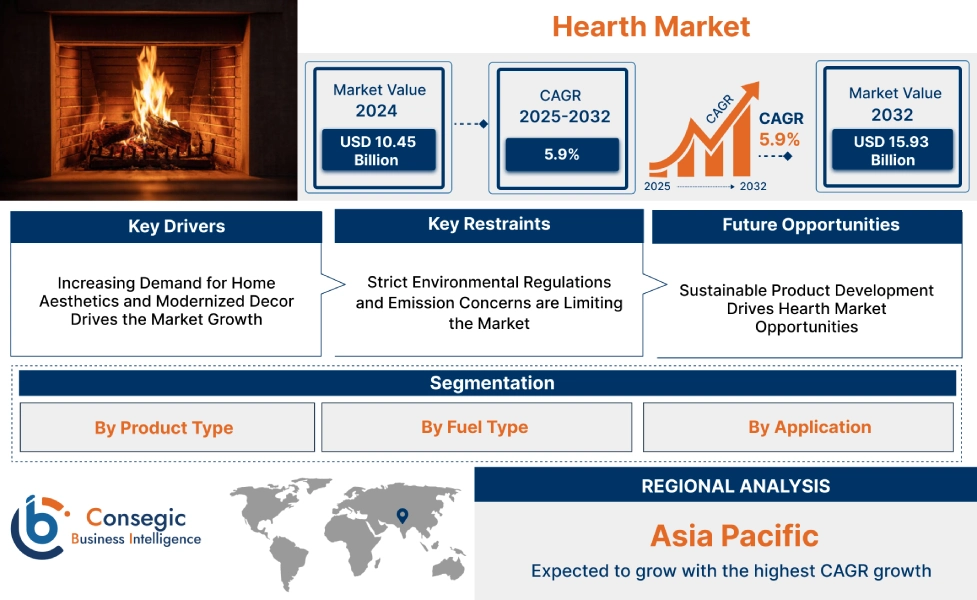Hearth Market Size:
Hearth Market is estimated to reach over USD 15.93 Billion by 2032 from a value of USD 10.45 Billion in 2024 and is projected to grow by USD 10.89 Billion in 2025, growing at a CAGR of 5.9% from 2025 to 2032.
Hearth Market Scope & Overview:
A hearth is fundamentally the floor of a fireplace, typically made of stone or brick, where a fire is built. The different types are fireplaces, stoves, and inserts. The key trend driving the hearth market includes increasing integration of smart home technologies, allowing for remote control and enhanced user convenience. Additionally, there's a significant shift towards sustainable product development, with growing consumer demand for eco-friendly and energy-efficient options across all fuel types. Moreover, increasing environmental regulations, particularly concerning air quality and emissions from traditional combustion, are compelling the hearth market to innovate towards cleaner and more sustainable heating solutions.
How is AI Impacting the Hearth Market?
AI is enabling the integration of hearth appliances into smart home ecosystems, allowing users to control heating remotely via voice commands or mobile apps. Also, AI-driven predictive maintenance algorithms can identify potential issues before they cause downtime, reducing maintenance costs and extending the lifespan of hearth appliances. Further, AI is helping manufacturers develop more sustainable hearth products by optimizing energy consumption and reducing emissions. Furthermore, AI is helping the hearth market adapt to changing consumer preferences, including the demand for customizable aesthetics and integration into modern homes.
Hearth Market Dynamics - (DRO) :
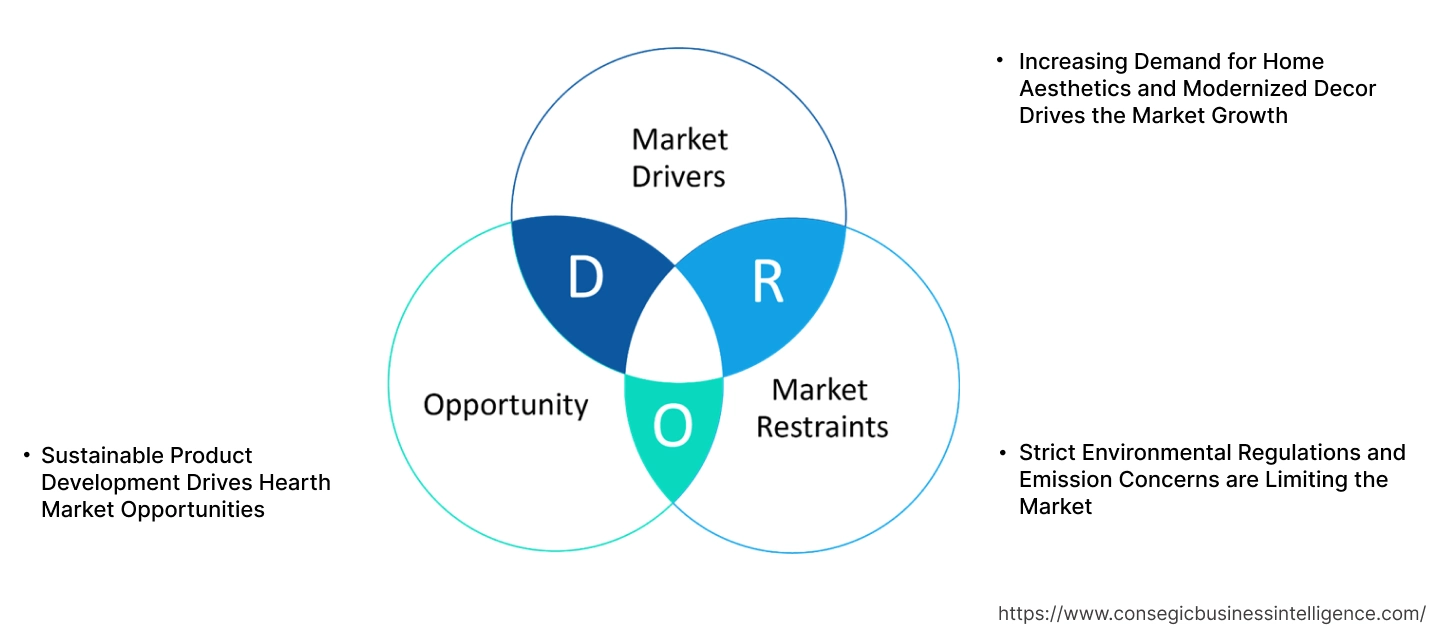
Key Drivers:
Increasing Demand for Home Aesthetics and Modernized Decor Drives the Market Growth
The rising need for sophisticated home aesthetics and modernized decor is a significant driver for the market growth. Homeowners are increasingly investing in creating visually appealing and comfortable living spaces. Further, fireplaces, stoves, and inserts are no longer viewed merely as heating devices but as central elements of interior design. This shift is fueled by a desire for products that not only offer warmth but also serve as stylish focal points, enhancing ambiance and reflecting individual tastes. Furthermore, increasing availability of diverse designs, materials, and customization options, coupled with the rising popularity of integrated smart home technologies are significantly boosting the market.
- For instance, FOCUS Fires offer Antefocus which is a unique suspended or wall-mounted fireplace that holds a significant place in the history of modern fireplace design.
Thus, increasing adoption driven by availability of diverse designs, materials, and customization contributes significantly to the hearth market size.
Key Restraints :
Strict Environmental Regulations and Emission Concerns are Limiting the Market
Strict environmental regulations and mounting emission concerns are limiting the hearth market, particularly for traditional wood-burning appliances. Governments are implementing more stringent air quality standards to combat particulate matter (PM2.5), carbon monoxide, and other hazardous pollutants. This leads to bans on certain fuel types, mandates for cleaner-burning technologies, and stricter installation requirements. This in turn results in increasing costs for manufacturers and consumers. The regulations promote shift towards more eco-friendly options like electric, gas, and advanced pellet fireplaces and simultaneously constrain the market for conventional, higher-emission products. Thus, regulatory pressure creates hurdles for market entry and sustained growth for less compliant solutions.
Future Opportunities :
Sustainable Product Development Drives Hearth Market Opportunities
Sustainable product development is rapidly becoming a significant opportunity for growth in the hearth market. With escalating environmental awareness and stricter regulations, consumers are actively seeking eco-friendly heating solutions. This drives demand for products that minimize emissions, utilize renewable energy sources, and have a reduced carbon footprint. Manufacturers are responding by innovating with advanced electric fireplaces, highly efficient gas hearths, and cutting-edge pellet stoves that meet stringent environmental standards. Obtaining green certifications and offering products made from recycled or sustainably sourced materials enhances brand credibility and opening new market segments. Thus, environmental awareness and stricter regulations drives hearth market opportunities.
Hearth Market Segmental Analysis :
By Product Type:
Based on the product type, the market is segmented into fireplaces, stoves, and inserts.
Trends in the Product Type:
- Increased need for pellet stoves due to their automated fuel feeding, efficient burning, and precise temperature control which in turn drives the hearth market trends.
- Increasing development of wood stoves with advanced combustion technologies to meet stricter environmental standards which is expected to drive hearth market size.
Fireplace accounted for the largest revenue share of 56.78% in the year 2024.
- Increasing demand for electric fireplaces and other ventless options like bioethanol or water vapor fireplaces is driving the hearth market share.
- Further, Fireplaces are featuring connectivity for control via smartphone apps, voice assistants, and home automation systems.
- Furthermore, there is growing preference for sleek, elongated fireplace designs that are integrated seamlessly into contemporary architectural styles which in turn drives the hearth market trends.
- Thus, as per hearth market analysis, popularity of electric and ventless fireplaces and integration with smart home systems is driving the market.
Inserts are anticipated to register the fastest CAGR during the forecast period.
- There is a widespread trend of homeowners replacing old, inefficient masonry fireplace openings with modern gas, pellet, or electric inserts.
- Further, new insert models are designed to significantly increase heat transfer into living space and reduce heat loss.
- Furthermore, inserts are available with a variety of decorative surrounds, faceplates, and trim kits to blend with existing decor which in turn drives the market.
- Therefore, based on analysis, conversion of existing fireplaces and emphasis on maximizing heat output is anticipated to boost the market during the forecast period.
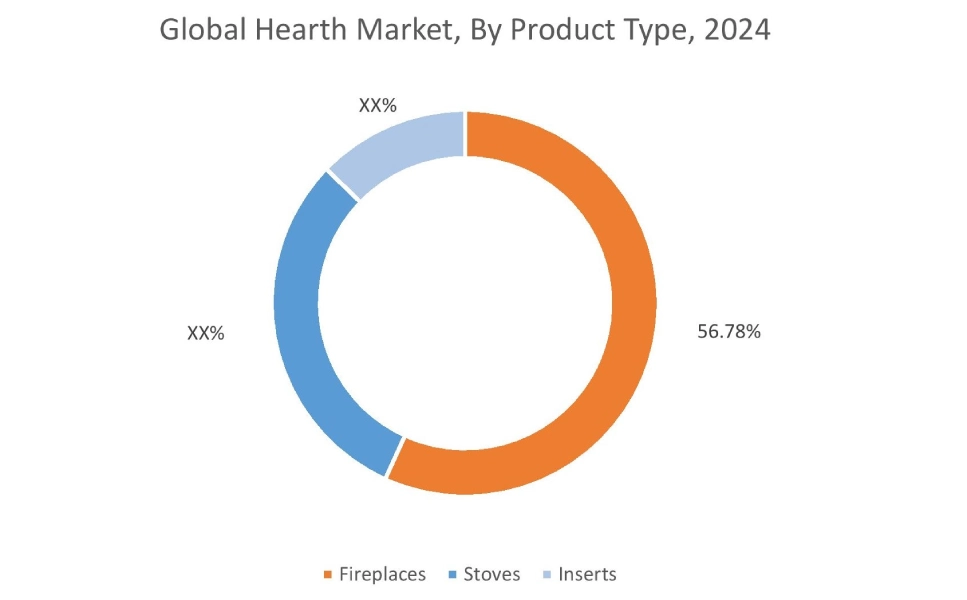
By Fuel Type:
Based on the fuel type, the market is segmented into wood, gas, electricity, and pellet.
Trends in the Fuel Type:
- Pellet stoves and inserts feature automatic pellet feeding systems and advanced controls for consistent heat and minimal user intervention which in turn drives the hearth market demand.
- New wood-burning units feature enhanced combustion systems that significantly reduce particulate emissions and improve efficiency, which in turn drives the hearth market share.
Gas accounted for the largest revenue share in the year 2024 and is anticipated to register the fastest CAGR during the forecast period.
- Growing preference for direct-vent gas fireplaces due to their safety, efficiency, and ability to be installed without a traditional chimney.
- Further, gas fireplaces and stoves are increasingly equipped with smart features for remote operation, programmable thermostats, and connectivity which in turn drives the hearth industry.
- Furthermore, manufacturers are continually improving the realism of gas flames and log sets to mimic the look of a wood-burning fire.
- For instance, in January 2023, Grand Canyon Gas Logslaunched a gas log technology for the open fireplace which in turn drove the market adoption.
- Thus, as per hearth market analysis, aforementioned factors are driving the market.
By Application:
Based on the application, the market is segmented into residential and commercial.
Trends in the Application:
- Fireplaces products are being incorporated into various commercial settings, including lobbies, communal areas, and retail environments, to create distinct zones and improve the overall aesthetic which in turn drives the hearth market expansion.
- Homeowners are actively seeking efficient inserts and replacement units to upgrade existing, less efficient fireplaces which subsequently propels the hearth market demand.
Residential accounted for the largest revenue share in the year 2024.
- Homeowners are increasingly focusing on products that seamlessly blend with modern, minimalist, or traditional interior aesthetics.
- Further, there is a growing trend of integrating residential heating systems with smart home systems which in turn drives the hearth market growth.
- Furthermore, rise in outdoor living spaces is anticipated to drive the hearth market growth.
- For instance, according to the United States Census Bureau, residential housing market is seeing significant growth, with 1,311,000 privately owned units recorded as of November 2024. This increasing investment in housing is expected to directly fuel market demand for both heating solutions and aesthetic ambiance within these homes.
- Thus, based on analysis, emphasis on aesthetic integration and increased adoption of smart home connectivity is driving the market.
Commercial is anticipated to register the fastest CAGR during the forecast period.
- Commercial establishments, particularly hotels, restaurants, and resorts, are extensively using heating products to create warm, inviting, and luxurious atmospheres for guests.
- Further, there is a growing adoption of products that offer visual appeal and unique design.
- Therefore, based on analysis, ambiance and focus on visual appeal is anticipated to boost the market during the forecast period.
Regional Analysis:
The regions covered are North America, Europe, Asia Pacific, Middle East and Africa, and Latin America.
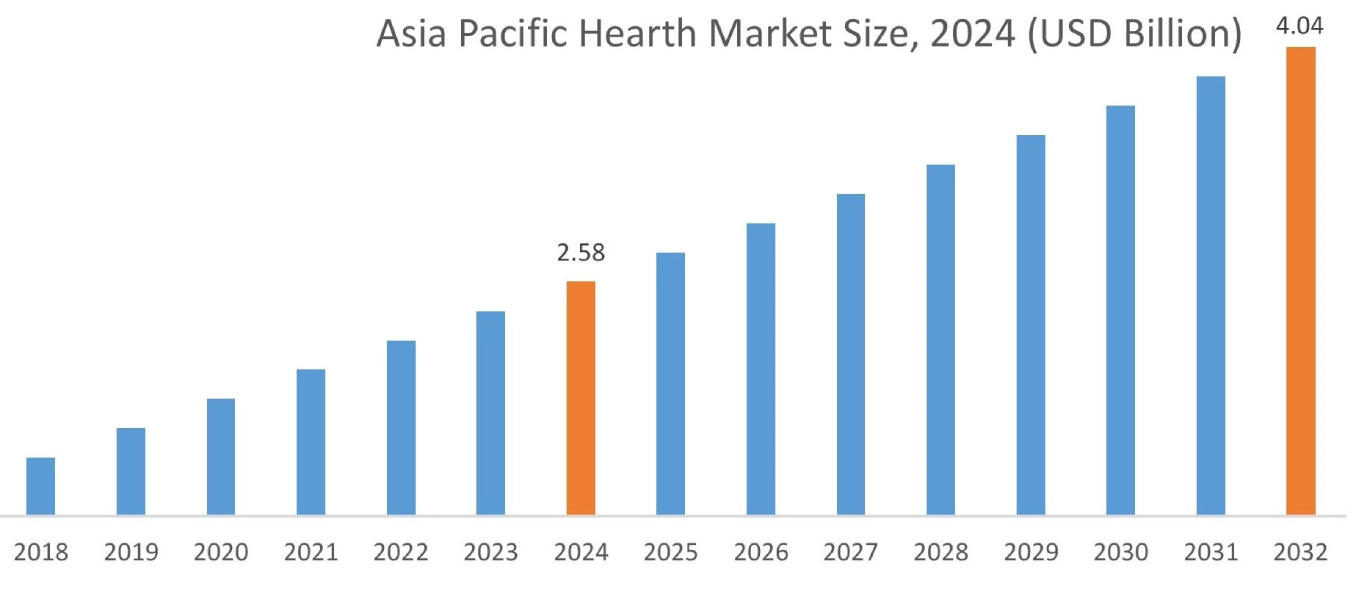
Asia Pacific region was valued at USD 2.58 Billion in 2024. Moreover, it is projected to grow by USD 2.70 Billion in 2025 and reach over USD 4.04 Billion by 2032. Out of this, China accounted for the maximum revenue share of 27.40%. The market for hearth is mainly driven by rapid urbanization and increasing disposable incomes, leading to a growing adoption of modernized and lavish home decor. Additionally, the flourishing hospitality industry, with its emphasis on enhancing guest experiences is further driving the hearth market expansion.
- For instance, in November 2023, Accor launched Tribe Nation in Chinawith new advancements in hospitality. This development is anticipated to boost the need for hearths, specifically to enhance lounge ambiance and create inviting spaces.
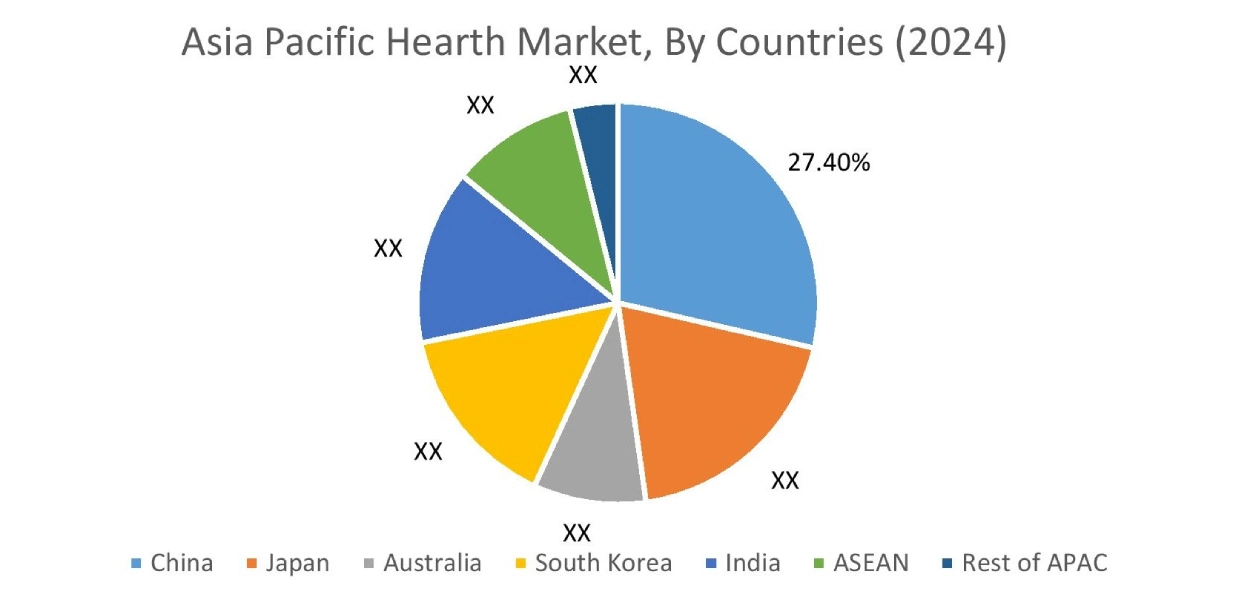
North America is estimated to reach over USD 5.56 Billion by 2032 from a value of USD 3.60 Billion in 2024 and is projected to grow by USD 3.75 Billion in 2025. The North American market is primarily driven by region's predominantly colder climates and the robust need for efficient space heating solutions in both residential and commercial sectors.
- For instance, in January 2023, Grand Canyon Gas Logslaunched new gas log technology for open fireplaces which significantly boosted its adoption within the market.
The regional analysis depicts stringent environmental regulations, colder climates, and technological advancement in Europe is driving the market. Additionally, growing focus on modern infrastructure and aesthetics is driving the market in the Middle East and African region is the. Further, growing middle class, expanding tourism and hospitality sectors, and increasing urbanization in Latin America region are driving the market.
Top Key Players & Market Share Insights:
The global hearth market is highly competitive with major players providing solutions to the national and international markets. Key players are adopting several strategies in research and development (R&D), product innovation, and end-user launches to hold a strong position in the hearth industry. Key players in the global hearth market include-
- Glen Dimplex (Ireland)
- Napoleon Premium Fire (Canada)
- Empire Comfort Systems Inc. (US)
- RH Peterson Co. (US)
- Hearth & Home Technologies (US)
- HNI Corporation (US)
- HPC Fire (US)
- Travis Industries Inc. (US)
- Innovative Hearth Products (US)
- Regency Fireplace (Canada)
Recent Industry Developments :
Product Launch
- In August 2024, Charnwood announced launch of its new Cranmore Insert Stove which is designed to fit seamlessly into existing fireplaces. This modern solution aims to enhance both the efficiency and elegance of a home.
Hearth Market Report Insights :
| Report Attributes | Report Details |
| Study Timeline | 2019-2032 |
| Market Size in 2031 | USD 15.93 Billion |
| CAGR (2024-2031) | 5.9% |
| By Product Type |
|
| By Fuel Type |
|
| By Application |
|
| By Region |
|
| Key Players |
|
| North America | U.S. Canada Mexico |
| Europe | U.K. Germany France Spain Italy Russia Benelux Rest of Europe |
| APAC | China South Korea Japan India Australia ASEAN Rest of Asia-Pacific |
| Middle East and Africa | GCC Turkey South Africa Rest of MEA |
| LATAM | Brazil Argentina Chile Rest of LATAM |
| Report Coverage |
|
Key Questions Answered in the Report
How big is the hearth market? +
The hearth market is estimated to reach over USD 15.93 Billion by 2032 from a value of USD 10.45 Billion in 2024 and is projected to grow by USD 10.89 Billion in 2025, growing at a CAGR of 5.9% from 2025 to 2032.
What specific segmentation details are covered in the hearth report? +
The hearth report includes specific segmentation details for product type, fuel type, application, and regions.
Which is the fastest segment anticipated to impact the market growth? +
In the hearth market, commercial is the fastest-growing segment during the forecast period.
Who are the major players in the hearth market? +
The key participants in the hearth market are Glen Dimplex (Ireland), HNI Corporation (US), HPC Fire (US), Travis Industries Inc. (US), Innovative Hearth Products (US), Regency Fireplace (Canada), Napoleon Premium Fire (Canada), Empire Comfort Systems Inc. (US), RH Peterson Co. (US), Hearth & Home Technologies (US) and others.
What are the key trends in the hearth market? +
The hearth market is being shaped by several key trends including increasing integration of smart home technologies, shift towards sustainable product development, and need for eco-friendly and energy-efficient solutions.
